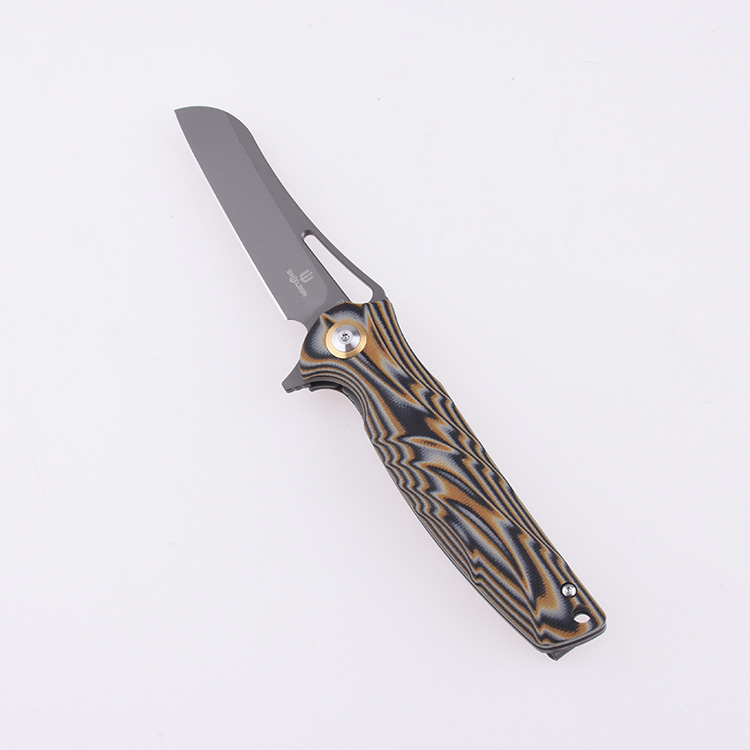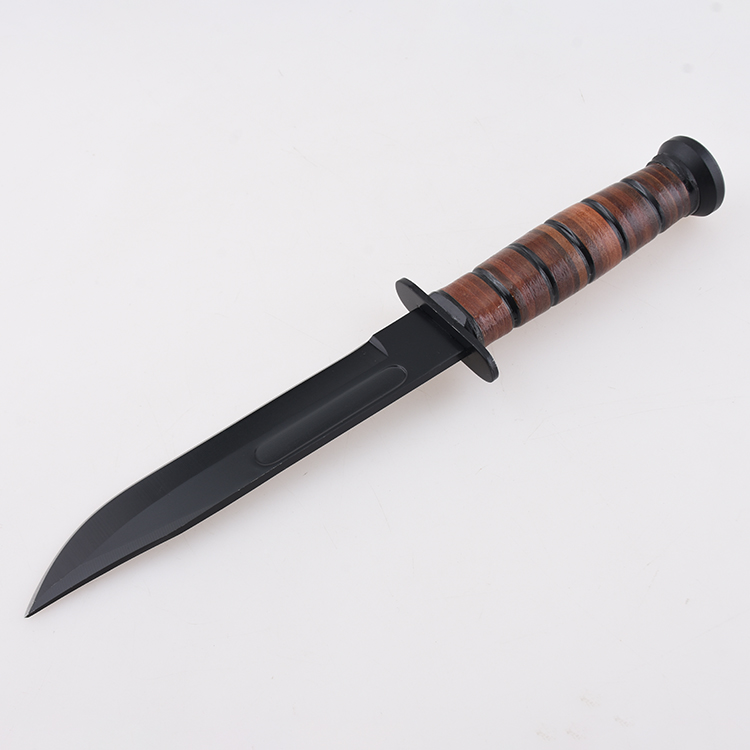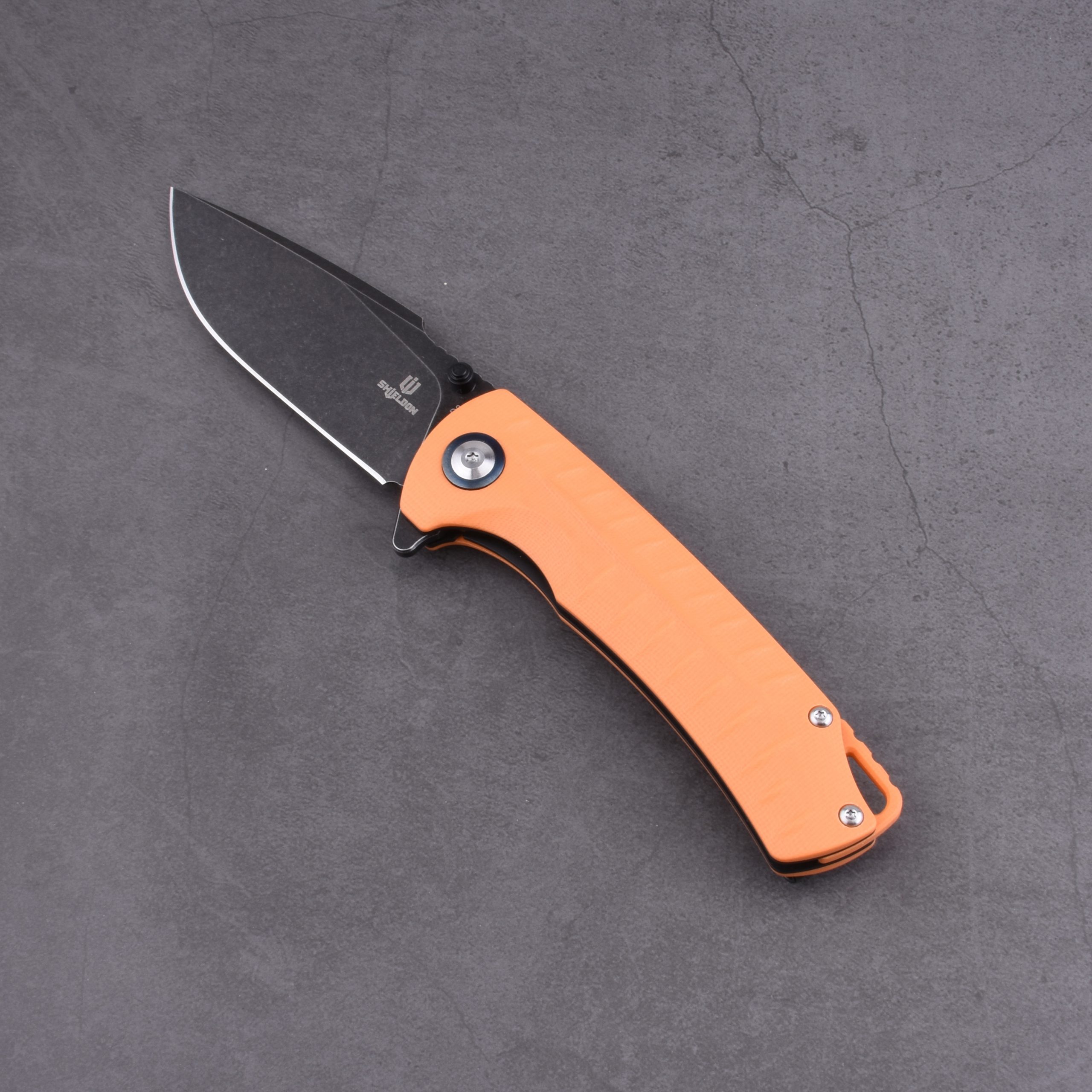4116 stainless steel is a popular choice for making pocket knives due to its good balance of performance, affordability, and usability.
With a hardness rating of 55-57 HRC on the Rockwell scale, it offers a mix of toughness and edge retention, which helps blades handle different cutting tasks without easily breaking or chipping.
The high carbon content provides decent edge retention, and it’s easy to sharpen, making it a practical option for users who prefer low-maintenance tools.
This versatile steel works well for various uses, from food prep to outdoor activities. Plus, its corrosion resistance and durability give you confidence in wet or wear-prone environments.
Overall, 4116 stainless steel is an economical yet effective choice for those looking for reliable performance in pocket knives.
Overview of 4116 Stainless Steel
Characteristics of 4116 Stainless Steel and Their Impact on Knife Performance
1.4116 steel, also known as X50CrMoV steel, is a type of stainless steel made by the German company ThyssenKrupp.
This steel is popular due to its resistance to corrosion and wear, as well as its ease of sharpening, although it offers moderate edge retention.
According to DIN standards, it is labeled as X50CrMoV15, where ‘X’ means it’s a stainless steel alloy, ’50’ shows a carbon content of 0.5%, ‘CrMoV’ refers to chromium, molybdenum, and vanadium, and ’15’ indicates the percentage of chromium.
Its performance is similar to AUS-8 steel, but it provides slightly better rust resistance.
Chemical Composition of 1.4116 Steel
- Carbon (C – 0.55%): Increases hardness, strength, and edge retention while enhancing resistance to rust and wear.
- Chromium (Cr – 15.00%): Enhances strength, hardness, and corrosion resistance through the formation of chromium carbide.
- Vanadium (V – 0.20%): Improves strength and toughness by preventing grain formation during processing and helps produce wear-resistant carbides.
- Molybdenum (Mo – 0.80%): Improves hot hardness and strengthens the steel, while also boosting its wear resistance.
- Phosphorus (P – 0.04%): Generally seen as an impurity, but in small amounts, it can improve strength and workability.
- Manganese (Mn – 1.00%): Boosts tensile strength and hardness, particularly during heat treatment.
- Silicon (Si – 1.00%): Contributes to toughness and makes the steel heat resistant.
- Sulfur (S – 0.02%): Enhances machinability, but excessive amounts are undesirable.
Iron, carbon, and other elements combine to give 1.4116 steel its key characteristics. With a carbon content of 0.55%, this steel offers better strength and wear resistance, while manganese helps it harden during treatment.
Performance Characteristics of 4116 Stainless Steel
Hardness and Wear Resistance
4116 stainless steel offers a Rockwell hardness rating of 55-57 HRC, making it tough enough to handle various cutting tasks without chipping or breaking easily.
The combination of its carbon content increases its strength and edge retention, though it’s important to note that it doesn’t match the hardness levels of some high-carbon steels like D2.
This means that while 4116 holds its edge well, it may require more frequent sharpening than harder options.
Corrosion Resistance Compared to Other Stainless Steel Grades
One of the key advantages of 4116 stainless steel is its excellent corrosion resistance, thanks to its 15% chromium content.
This makes it a reliable choice for knives that will be used in wet or humid environments.
When comparing it to other stainless steel grades, such as 440C, which contains a higher chromium content but is more expensive, 4116 shows a good balance of performance and affordability.
Meanwhile, D2 steel lacks the stainless properties entirely, making it more prone to rust, especially if not maintained properly.
Processing and Heat Treatment Characteristics
Processing 4116 stainless steel is relatively straightforward, allowing it to be shaped and crafted with ease.
During heat treatment, this steel benefits from its composition, which enhances its toughness and durability. Proper heat treatment is important as it helps to maximize its hardness and performance characteristics.
For DIY enthusiasts and professionals alike, understanding how to heat-treat and sharpen 4116 can lead to better-performing knives that stand the test of time.
Comparison of 4116 Stainless Steel with Other Steels
1.4116 Steel vs. D2 Steel
D2 steel contains 1.40% to 1.60% carbon, making it very tough and wear-resistant. This high hardness helps D2 keep its edge longer than 4116 steel.
However, it lacks enough chromium to be considered stainless, so it can rust if not properly maintained.
While D2 is commonly used in industrial applications like cutting tools and punches, it is generally more expensive than 4116 steel.
1.4116 Steel vs. 440C Stainless Steel
440C stainless steel comprises 17% to 18% chromium and features a higher carbon content of 1.1%.
This blend significantly enhances its hardness and wear resistance, resulting in superior edge retention compared to 4116 steel.
While both 4116 and 440C are relatively easy to sharpen, 440C typically comes at a higher price point.
1.4116 Steel vs. 7Cr17MoV Steel
7Cr17MoV is a Chinese stainless steel that contains 0.7% carbon and 17% to 18% chromium. This high chromium content delivers exceptional corrosion resistance, while the carbon enhances its hardness.
Thanks to its superior toughness and edge retention compared to 4116 steel, 7Cr17MoV is a popular choice for combat knives.
4116 Steel vs. 440C Steel
The key difference between 4116 and 440C steel is their chromium content. 4116 contains 13% to 15% chromium, making it less resistant to corrosion than 440C, which has 16% to 18% chromium.
As a result, 440C is much harder and more wear-resistant, so it can be sharpened to a finer edge.
Both 4116 and 440C are popular for knives and cutting tools. 4116 is often used in food-related items like kitchen utensils and food processing equipment because it offers a good balance of hardness and corrosion resistance.
4116 Steel vs. AUS-8
When comparing 4116 steel and AUS-8, both are excellent choices for knives and cutting tools, known for their great edge retention and resistance to corrosion. They are easy to sharpen and very tough.
However, 4116 steel is more commonly available, which makes it a more accessible option for many shoppers.
4116 is a martensitic stainless steel with chromium content of 13% to 15%, while AUS-8 has carbon levels between 0.75% and 1.5%.
Both steels are durable, but 4116 typically offers better corrosion resistance. In hardness, 4116 can reach a Rockwell hardness of 58, while AUS-8 can hit 60, making AUS-8 slightly harder but potentially more prone to rust.
Maintenance and Care of 4116 Stainless Steel
To ensure that your 4116 stainless steel knives remain in peak condition, following a detailed maintenance routine is crucial.
The longevity and performance of these knives can be significantly enhanced through careful handling and regular upkeep. Here are essential tips for maintaining your knives:
- Cleaning: After each use, promptly wash your knives by hand using warm water and a gentle dish soap. It’s important to avoid abrasive sponges or harsh cleaners that can scratch the surface and diminish the blade’s finish. For stubborn residues, soak the knife briefly rather than scrubbing intensely.
- Drying: Always dry your knives immediately after washing. Use a soft cloth or paper towel to remove moisture entirely. This step is vital to prevent water spots and potential rust. For extra protection, consider applying a thin film of mineral oil after drying, which can fend off moisture and keep the blade looking pristine.
- Sharpening: Maintaining a sharp edge is essential for both safety and performance. Regularly hone your knife using a ceramic or steel honing rod before each use to realign the blade edge. For more thorough sharpening, utilize a whetstone or a diamond sharpener when the knife begins to dull. Aim for a sharpening angle of around 20 degrees and proceed with light, even strokes, ensuring alternate sides for balanced sharpening.
- Storage: Proper storage can prevent damage and dulling of the blade. Store your knives in a designated knife block, on a magnetic strip, or in protective sheaths to avoid contact with other utensils. If using a drawer, consider in-drawer knife trays to ensure blades don’t rub against one another.
- Avoiding Dishwashers: Never place 4116 stainless steel knives in the dishwasher. The intense heat, moisture, and tumbling action can lead to dulling edges, surface abrasions, and possible corrosion. Hand washing is always the preferred method for maintaining knife integrity.
- Routine Inspections: Periodically check your knives for signs of wear, chipping, or corrosion. Addressing any issues early can prevent more significant damage later. If rust spots appear, gently scrub them off using fine steel wool and reapply oil to the affected areas.
By adhering to these maintenance practices, you will not only extend the lifespan of your 4116 stainless steel knives but also enhance their cutting performance, ensuring they remain reliable tools in your kitchen or toolkit for years to come.
Limitations and Alternatives of 4116 Stainless Steel
○ Discuss potential limitations of 4116 stainless steel as a material for knives
○ Explore other alternative steels on the market and their potential advantages
5Cr15MoV, some knives manufacturers define as 5Cr13MoV, the hardness could be 55–57 HRC. It’s widely used to make kitchen knives, high-end scissors, folding knives, hunting knives, etc. It is equivalent to 1.4116 and German 4116 steel in composition.
Limitations and Alternatives of 4116 Stainless Steel
While 4116 stainless steel is a popular choice for knives due to its corrosion resistance and ease of sharpening, it does have some limitations:
Limitations of 4116 Stainless Steel
- Edge Retention: Although 4116 provides good edge retention, it does not hold an edge as long as some higher-carbon stainless steels. Frequent sharpening might be required for those who use their knives regularly.
- Hardness: With a Rockwell hardness rating of about 58, 4116 is softer compared to steels like AUS-8 or 440C, which can make it less ideal for heavy-duty cutting tasks. Softer steels are more prone to rolling or dulling under pressure.
- Corrosion Resistance: While 4116 has decent corrosion resistance, it may not perform as well in extreme environments or when exposed to highly acidic foods compared to steels with higher chromium content.
- Strength: 4116, being a softer steel, may not be the best choice for applications requiring high strength or toughness, such as heavy outdoor tasks.
Alternatives to 4116 Stainless Steel
440C Stainless Steel
The material in question is characterized by its elevated levels of chromium, ranging from 16% to 18%, and a carbon content of 1.1%.
These specific proportions play a crucial role in enhancing the hardness of the material, which significantly contributes to its edge retention capabilities.
This means that tools or equipment made from this material will maintain their sharpness and effectiveness over extended periods, reducing the need for frequent sharpening.
Moreover, this composition makes it particularly well-suited for users who are in search of superior wear resistance and durability.
Whether for professional use or personal projects, this material offers a reliable solution that can withstand the rigors of demanding tasks while ensuring long-lasting performance.
Those who prioritize quality and longevity in their tools will find this material to be an excellent choice, as it combines both strength and resilience to meet various challenges.
Acero AUS-8
The material in question offers a great balance of hardness and toughness, reaching up to 60 HRC, making it an excellent choice for various knives.
This hardness helps the blades keep a sharp edge, while the toughness allows them to handle regular use without chipping or breaking.
Additionally, it has better edge retention than 4116, meaning knives made from this material will need sharpening less often, improving their usability.
However, it’s important to remember that this performance comes with a downside; the material is more prone to rust if not properly cared for.
Regular cleaning and maintenance are crucial to keep it in good shape, especially in humid environments.
5Cr15MoV Steel
The material in question is similar to 4116 but is often more accessible and available at lower prices, making it an appealing choice for many.
Its affordability doesn’t compromise quality; it has decent hardness and excellent edge retention, making it great for kitchen knives and various cutting tools.
These features ensure that the blades stay sharp over time, offering reliable kitchen performance. Additionally, the versatility of this material allows for use in different applications, making it popular among both home cooks and professional chefs.
With its combination of availability, cost-effectiveness, and performance, this material is a practical option for anyone looking to buy high-quality cutting tools.
D2 Tool Steel
High-carbon tool steel is renowned for its exceptional toughness and impressive wear resistance, making it a top choice among manufacturers of heavy-duty knives.
This material stands out due to its ability to withstand significant stress and impact, which is particularly advantageous in demanding environments where durability is required.
However, while its strength and resilience make it appealing, it’s important to note that high-carbon tool steel is also more susceptible to rust compared to other materials.
This characteristic necessitates a higher level of maintenance to ensure the longevity of the knives crafted from it.
Regular care, such as proper cleaning and oiling, can help mitigate the risk of corrosion, allowing users to fully enjoy the benefits of this remarkable steel.
Conclusión
In summary, 4116 stainless steel presents a balanced option for knife enthusiasts, offering decent corrosion resistance, ease of sharpening, and good enough edge retention for everyday tasks.
However, it has limitations, especially in hardness and long-term durability compared to other steels like 440C and AUS-8. When choosing steel for knives, it’s important to consider the specific use case and maintenance needs to ensure optimal performance.
For those seeking a reliable knife manufacturer, Shieldon stands out by offering an OEM service that caters to diverse client needs.
With a commitment to quality and innovation, Shieldon provides customized solutions, ensuring that every blade produced meets the highest standards of durability and functionality.
Whether you’re looking to develop a bespoke product or source high-quality knives for personal or commercial use, Shieldon’s expertise and dedication to excellence in knife production make it a preferred partner in the industry.
Preguntas más frecuentes
What are the main components of 4116 stainless steel?
The main components of 4116 stainless steel include approximately 0.4% carbon, 12-14% chromium, 0.6% molybdenum, 0.3% manganese, and small amounts of silicon and phosphorus. This composition contributes to its decent corrosion resistance and ease of sharpening, making it a suitable choice for everyday cutting tasks, albeit with limitations in hardness and durability compared to higher-grade steels.
What is the hardness and wear resistance of 4116 stainless steel?
The hardness of 4116 stainless steel is typically around 55-57 HRC (Rockwell hardness), which provides a reasonable balance between toughness and edge retention.
However, it is not as hard as some higher-grade steels, making it less suitable for heavy-duty applications that require extreme durability.
In terms of wear resistance, 4116 offers decent performance for everyday cutting tasks, but its softer composition means it may wear down more quickly than harder steels like 440C or D2 tool steel.
Regular maintenance, such as sharpening and proper care, can help extend its useful life in various applications.
What are the advantages of 4116 stainless steel compared to other stainless steels like 440C?
The advantages of 4116 stainless steel compared to other stainless steels like 440C include its ease of sharpening and relatively decent corrosion resistance.
4116 is known for being user-friendly, making it ideal for everyday applications where users may need to sharpen their knives frequently.
Additionally, while 440C offers greater hardness and edge retention, 4116’s composition allows for sufficient performance in less demanding tasks without the need for extensive maintenance.
This balance of features makes 4116 a practical choice for those seeking functional cutting tools without the complexities of higher-grade steels.
What is the corrosion resistance of 4116 stainless steel?
4116 stainless steel has decent corrosion resistance, primarily due to its chromium content, which helps form a protective oxide layer.
However, it is more susceptible to rust compared to higher-grade stainless steels like 440C, especially if not properly maintained.
Regular cleaning and care are essential to prevent corrosion, particularly in humid environments.
What are the common uses of 4116 stainless steel in pocket knife manufacturing?
4116 stainless steel is commonly used in the manufacturing of pocket knives due to its balance of corrosion resistance, ease of sharpening, and affordability.
It is particularly suitable for everyday carry (EDC) knives, utility knives, and general-purpose folding knives.
Its decent edge retention makes it effective for routine cutting tasks, while its lower hardness allows for quick maintenance and sharpening, appealing to casual users and those who require a practical, reliable blade for various applications.







